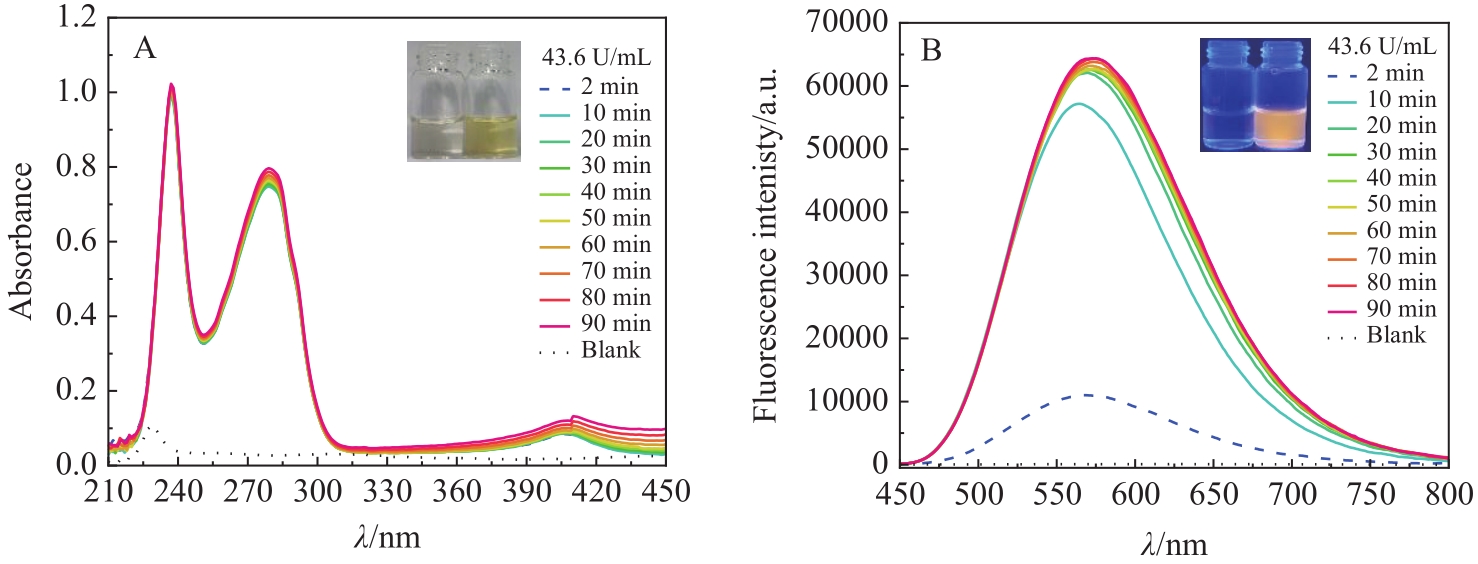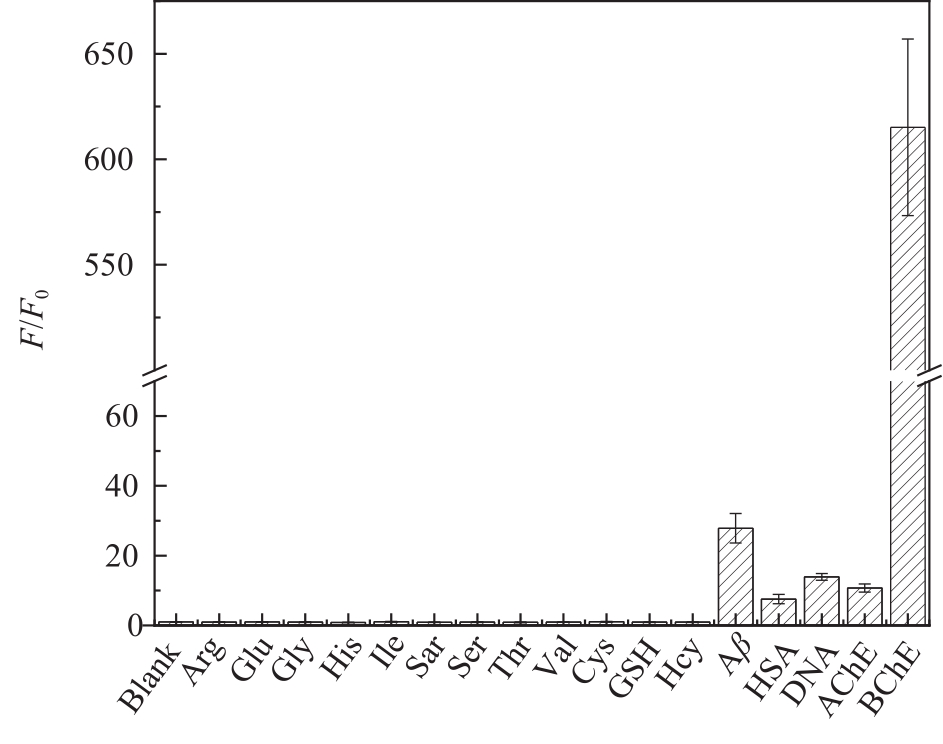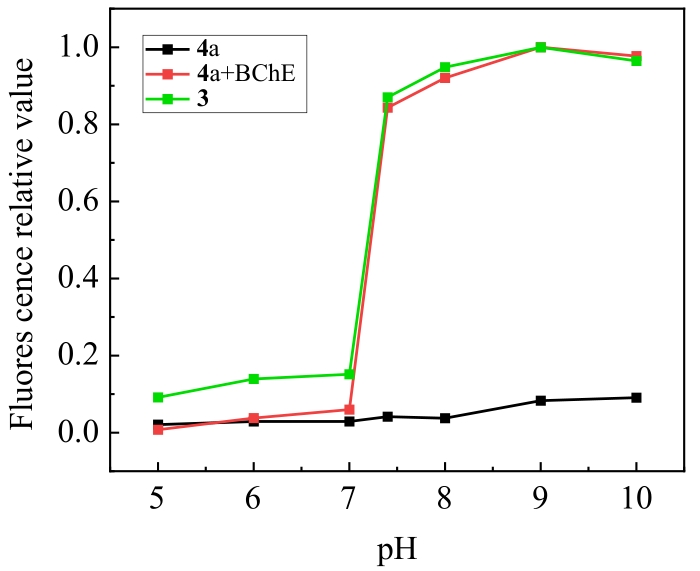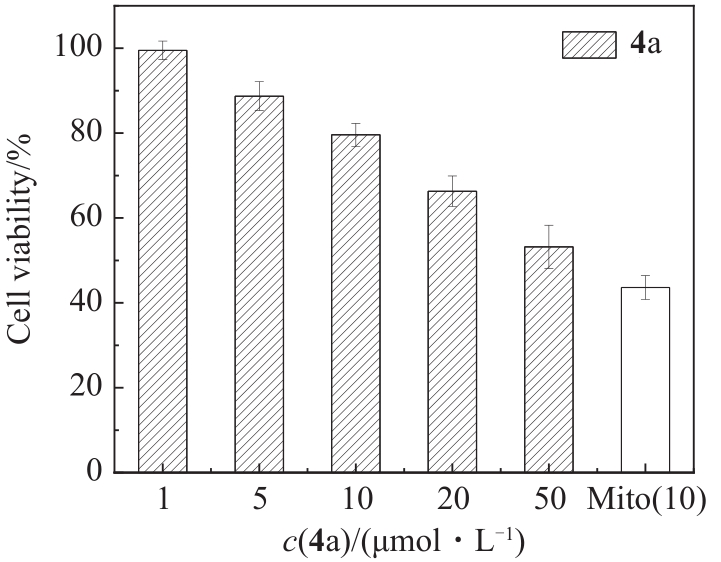
Chinese Journal of Applied Chemistry ›› 2023, Vol. 40 ›› Issue (4): 500-508.DOI: 10.19894/j.issn.1000-0518.220308
• Full Papers • Previous Articles Next Articles
A Flavone-based “Off-On” Fluorescence Probe for Detecting Butyrylcholinesterase in Living Cell
Hong-Li YU1,2, Si-Yi ZHOU2, Chen HONG1( ), Wen LUO2(
), Wen LUO2( )
)
- 1.Huaihe Hosipital,Henan University,Kaifeng 475000,China
2.Key Laboratory of Natural Medicine and Immuno-Engineering,Henan University,Kaifeng 475004,China
-
Received:2022-09-20Accepted:2023-02-14Published:2023-04-01Online:2023-04-17 -
Contact:Chen HONG,Wen LUO -
About author:luowen83@163.com
hongchenbest@163.com
-
Supported by:the Science and Technology Planning Project of Henan Province(212102311030)
CLC Number:
Cite this article
Hong-Li YU, Si-Yi ZHOU, Chen HONG, Wen LUO. A Flavone-based “Off-On” Fluorescence Probe for Detecting Butyrylcholinesterase in Living Cell[J]. Chinese Journal of Applied Chemistry, 2023, 40(4): 500-508.
share this article
Add to citation manager EndNote|Ris|BibTeX
URL: http://yyhx.ciac.jl.cn/EN/10.19894/j.issn.1000-0518.220308
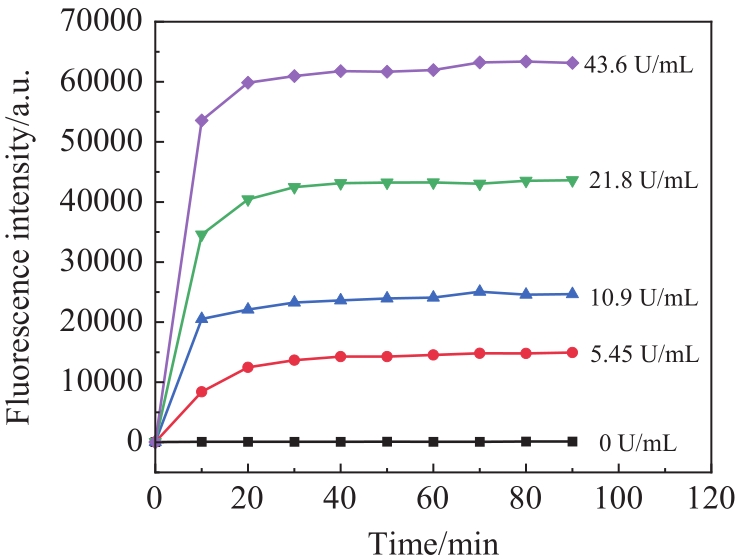
Fig.4 A plot of fluorescence intensity at 574 nm vs the reaction time for the probe 4a (10 μmol/L) in PBS in the presence of different amounts of BChE (λex= 430 nm, slit: 2.0/0.5 nm)
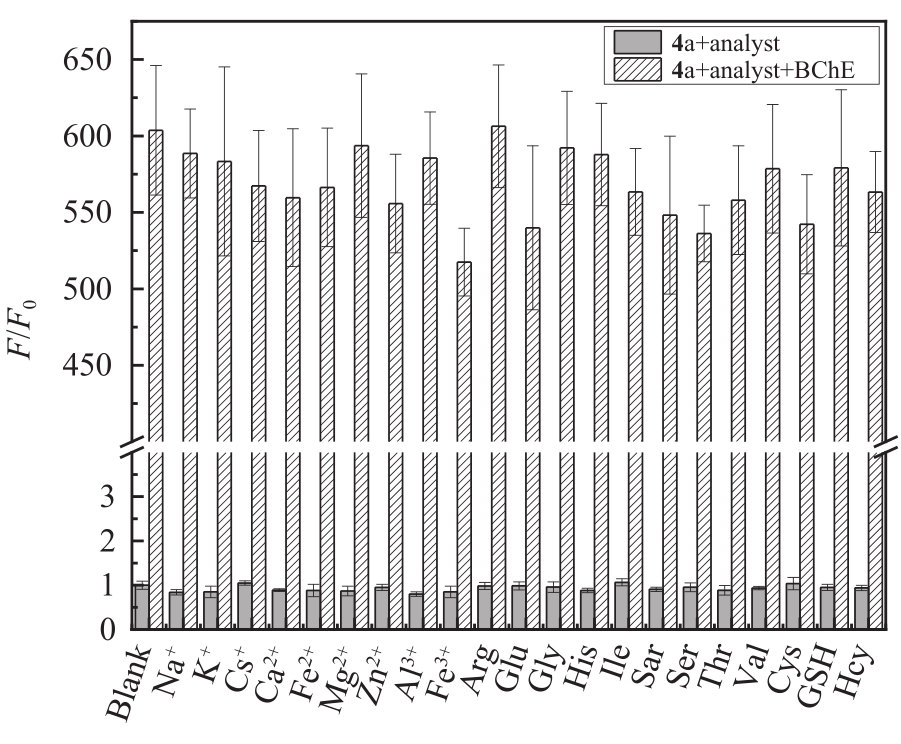
Fig.6 Fluorescence intensity (574 nm) of probe 4a (10 μmol/L) with BChE (43.6 U/mL) and the interference of coexisting various small molecules (50 μmol/L) in PBS

Fig.10 Response of BChE by probe 4a (10 μmol/L) in living HepG2 cells pretreated without (A-C) or with tacrine (D-F).(A).(D) dark field, (B).(E) bright field, (C).(F) merged
| 1 | LOCKRIDGE O. Review of human butyrylcholinesterase structure, function, genetic variants, history of use in the clinic, and potential therapeutic uses[J].Pharmacol Ther, 2015, 148: 34-46. |
| 2 | DIVR H, SILMAN I, HAREL M, et al. Acetylcholinesterase: from 3D structure to function[J]. Chem Biol Interact, 2010, 187: 10-22. |
| 3 | IBACH B, HAEN E. Acetylcholinesterase inhibition in Alzheimer's disease[J]. Curr Pharm Des, 2004, 10: 231-251. |
| 4 | LIU S Y, XIONG H, YANG J Q, et al. Discovery of butyrylcholinesterase-activated near-infrared fluorogenic probe for live-cell and in vivo imaging[J]. ACS Sens, 2018, 3: 2118-2128. |
| 5 | DARVESH S, HOPKINS D, GEULA C. Neurobiology of butyrylcholinesterase[J]. Nat Rev Neurosci, 2003,4: 131-138. |
| 6 | CHEN G L, FENG H, JIANG X G, et al. Redox-controlled fluorescent nanoswitch based on reversible disulfide and its application in butyrylcholinesterase activity assay[J]. Anal Chem, 2018, 90: 1643-1651. |
| 7 | YU Z, DONG W, WU S, et al. Identification of ovalbumin-derived peptides as multi-target inhibitors of AChE, BChE, and BACE1[J]. J Sci Food Agric, 2020, 100: 2648-2655. |
| 8 | GREIG N H, LAHIRI D K, SAMBAMURTI K. Butyrylcholinesterase: an important new target in Alzheimer's disease therapy[J]. Int Psychogeriatr, 2002, 14: 77-91. |
| 9 | RAO A A, SRIDHAR G R, DAS U N. Elevated butyrylcholinesterase and acetylcholinesterase may predict the development of type 2 diabetes mellitus and Alzheimer's disease[J].Med Hypoth, 2007, 69(6): 1272-1276. |
| 10 | RENOU J, LOIODICE M, ARBOLÉAS M, et al. Tryptoline-3-hydroxypyridinaldoxime conjugates as efficient reactivators of phosphylated human acetyl and butyrylcholinesterase[J]. Chem Commun, 2014, 50: 3947-3950. |
| 11 | ZHOU G, WANG F, WANG H, et al. Colorimetric and fluorometric assays based on conjugated polydiacetylene supramolecules for screening acetylcholinesterase and its inhibitors[J]. ACS Appl Mater Interfaces, 2013, 5: 3275-3280. |
| 12 | ELLMAN G L, COURTNEY K D, ANDRES V, et al. A new and rapid colorimetric determination of acetylcholinesterase activity[J]. Biochem Pharmacol, 1961, 7: 88-95. |
| 13 | LIAO S Z, HAN W T, DING H Z, et al. Modulated dye retention for the signal-on fluorometric determination of acetylcholinesterase inhibitor[J]. Anal Chem, 2013, 85: 4968-4973. |
| 14 | MIAO Y, HE N, ZHU J J. History and new developments of assays for cholinesterase activity and inhibition[J]. Chem Rev, 2010, 110: 5216-5234. |
| 15 | HOLAS O, MUSILEK K, POHANKA M. et al. The progress in the cholinesterase quantification methods[J]. Expert Opin Drug Discov, 2012, 7: 1207-1223. |
| 16 | CHEN Z, REN X, MENG X, et al. Quantum dots-based fluorescent probes for turn-on and turn-off sensing of butyrylcholinesterase[J]. Biosens Bioelectron, 2013, 44: 204-209. |
| 17 | XU D, LIN Q, CHANG H T. Recent advances and sensing applications of carbon dots[J]. Small Methods, 2020, 4: 1900387. |
| 18 | SUN X, ZHAI C, WANG X. A novel and highly sensitive acetyl-cholinesterase biosensor modified with hollow gold nanospheres[J]. Bioprocess Biosyst Eng, 2013, 36: 273-283. |
| 19 | ZHANG X P, ZHAO C X, SHU Y, et al. Gold nanoclusters/iron oxyhydroxide platform for ultrasensitive detection of butyrylcholinesterase[J]. Anal Chem, 2019, 91: 15866-15872. |
| 20 | MA J, LU X, ZHAI H, et al. Rational design of a near-infrared fluorescence probe for highly selective sensing butyrylcholinesterase (BChE) and its bioimaging applications in living cell[J]. Talanta, 2020, 219: 121278. |
| 21 | ZHANG Q, FU C, GUO X, et al. Fluorescent determination of butyrylcholinesterase activity and its application in biological imaging and pesticide residue detection[J]. ACS Sens, 2021, 6: 1138-1146. |
| 22 | WAN C, LI J, GAO J, et al. Ratiometric fluorescence assay for butyrylcholinesterase activity based on a hemicyanine and its application in biological imaging[J]. Dyes Pigm, 2022, 197: 109874. |
| 23 | CAO T, ZHENG L, ZHANG L, et al. A highly butyrylcholinesterase selective red-emissive mitochondria-targeted fluorescent indicator imaging in liver tissue of mice[J]. Sens Actuators B: Chem, 2021, 330: 129348. |
| 24 | YANG Y X, ZHANG L, WANG J M, et al. Diagnosis of Alzheimer's disease and in situ biological imaging via an activatable near-infrared fluorescence probe[J]. Anal Chem, 2022, 94(39): 13498-13506. |
| 25 | PRONIN D, KRISHNAKUMAR S, RYCHLIK M, et al. Development of a fluorescent probe for measurement of singlet oxygen scavenging activity of flavonoids[J]. Agric Food Chem,2019, 67(38): 10726-10733. |
| 26 | TONG C Y, SHI F Y, TONG X, et al. Shining natural flavonols in sensing and bioimaging[J]. Trends Anal Chem, 2021, 137, 116222. |
| 27 | 鞠志宇, 舒鹏华, 谢智宇, 等. 一种黄酮荧光探针对肼的识别及细胞成像[J]. 有机化学, 2019, 39(3): 697-702. |
| JU Z Y, SHU P H, XIE Z Y, et al. A flavone-based fluorescent probe for hydrazine and its bioimaging in live cells[J]. Chin J Org Chem, 2019, 39(3): 697-702. | |
| 28 | QIN T, HUANG Y, ZHU K, et al. A flavonoid-based fluorescent test strip for sensitive and selective detection of a gaseous nerve agent simulant[J]. Anal Chim Acta, 2019, 1076: 125-130. |
| 29 | ZHU K, LV T, QIN T, et al. A flavonoid-based fluorescent probe enables the accurate quantification of human serum albumin by minimizing the interference from blood lipids[J]. Chem Commun, 2019, 55: 13983-13986. |
| 30 | QIN T, LIU B, HUANG Y, et al. Ratiometric fluorescent monitoring of methanol in biodiesel by using an ESIPT-based flavonoid probe[J]. Sens Actuators B: Chem, 2018, 277: 484-491. |
| 31 | 杨亚成, 赵永梅, 王清照, 等.一种裸眼识别的反应型铜离子荧光探针[J]. 精细化工, 2018, 35(4): 569-573. |
| YANG Y C, ZHAO Y M, WANG Q Z, et al. A reactive copper ion fluorescence probe for naked eye recognition[J]. Fine Chem,2018, 35(4): 569-573. | |
| 32 | BORTOLAMI M, ROCCO D, MESSORE A, et al. Acetylcholinesterase inhibitors for the treatment of Alzheimer's disease-a patent review (2016-present)[J]. Expert Opin Ther Pat, 2021, 31: 399-420. |
| 33 | MESULAM M, GUILLOZET A, SHAW P, et al. Acetylcholinesterase knockouts establish central cholinergic pathways and can use butyrylcholinesterase to hydrolyze acetylcholine[J].Neuroscience, 2002, 110: 627-639. |
| 34 | 王莲萍, 李庆杰, 刘晓艳, 等. 基于UFLC-MS/分子模拟计算的吴茱萸醇提取物中胆碱酯酶抑制剂筛选[J]. 高等学校化学学报, 2020, 41(1): 111-117. |
| WANG L P, LI Q J, LIU X Y, et al. Screening of cholinesterase inhibitors from alcohol extract of Evodia rutaecarpa based on UFLC-MS/molecular simulation[J]. Chem J Chin Univ,2020, 41(1): 111-117. | |
| 35 | YANG S H, SUN Q, XIONG H, et al. Discovery of a butyrylcholinesterase-specific probe via a structure-based design strategy[J]. Chem Commun, 2017, 53: 3952-3955. |
| 36 | https://www.sigmaaldrich.cn/deepweb/assets/sigmaaldrich/product/documents/330/255/c1057enz.pdf. |
| 37 | WANG X, LI P, DING Q, et al. Observation of acetylcholinesterase in stress-induced depression phenotypes by two-photon fluorescence imaging in the mouse brain[J]. J Am Chem Soc, 2019, 141: 2061-2068. |
| 38 | OSET-GASQUE M J, GONZÁLEZ M P, PÉREZ-PEÑA J, et al. Toxicological and pharmacological evaluation, antioxidant, ADMET and molecular modeling of selected racemic chromenotacrines {11-amino-12-aryl-8,9,10,12-tetrahydro-7H-chromeno[2,3-b]quinolin-3-ols} for the potential prevention and treatment of Alzheimer's disease[J]. Eur J Med Chem, 2014, 74: 491-501. |
| [1] | ZHANG Cheng-Lu, BAO Jin-Di, YU Feng-Ming, DONG Wen-Jing, ZHANG Yang, GONG Rong-Qing, ZHANG Yan-Peng, ZHANG Lu. Synthesis and Application of a Fluorescence Probe with Quinazolinone as the Core Block for Highly Selective and Sensitive Detection of Hypochlorite Ion [J]. Chinese Journal of Applied Chemistry, 2021, 38(8): 986-994. |
| [2] | XU Liping, LIU Qingshi, DONG Zhichen, GUO Xingjia, DONG Wei. Simple, Fast and Accurate Detection of Ciprofloxacin Based on Fluorescence Enhancement of Nitrogen-Doped Carbon Dots [J]. Chinese Journal of Applied Chemistry, 2020, 37(7): 830-838. |
| [3] | ZHANG Yingying, WANG Liyan, ZHAO Bing, SONG Bo. A Benzoindole-Based Probe for Recognition of Al3+ and Its Application [J]. Chinese Journal of Applied Chemistry, 2020, 37(1): 88-95. |
| [4] | ZHANG Chenglu, WANG Jing, LI Jingyi, YU Xiangkun, YANG Jingyi, CAI Jinhua, LI Yizhen, WANG Huayu, GONG Rongqing. Synthesis of 1,2,4-Triazine-PhenanthrolineCo(Ⅲ) Complexes and Their FluorescenceRecognition on Calf Thymus DNA [J]. Chinese Journal of Applied Chemistry, 2019, 36(2): 212-222. |
| [5] | WANG Tao,MA Lamaocao,MA Hengchang. Research Progress on Cell Imaging Based on the Aggregation-induced Emission Fluorescent Probes [J]. Chinese Journal of Applied Chemistry, 2018, 35(10): 1155-1165. |
| [6] | HUANG Zike, LIU Chao, FU Qiangqiang, LI Jin, ZOU Jianmei, XIE Sitao, QIU Liping. Aptamer-based Fluorescence Probe for Bioanalysis and Bioimaging [J]. Chinese Journal of Applied Chemistry, 2018, 35(1): 28-39. |
| [7] | LIU Chuantao, XIAO Ting, WANG Fang, CHEN Xiaoqiang. Synthesis of Binol-based Fluorescence Probe and Recognition of Arginine [J]. Chinese Journal of Applied Chemistry, 2018, 35(1): 40-45. |
| [8] | WANG Dejia, XU Yongqian, SUN Shiguo, LI Hongjuan. Advanced in Fluorescent Probes Based on Excited State Intramolecular Proton Transfer [J]. Chinese Journal of Applied Chemistry, 2018, 35(1): 1-20. |
| [9] | LIU Chuantao, XIAO Ting, WANG Fang, CHEN Xiaoqiang. Synthesis of Binol-based Fluorescence Probe and Recognition of Arginine [J]. Chinese Journal of Applied Chemistry, 2018, 35(1): 0-0. |
| [10] | SHI Weining,XU Yongqian,SUN Shiguo,LI Hongjuan. Research Progress on Application of Fluorescent Sensors Based on Squaraine Dyes [J]. Chinese Journal of Applied Chemistry, 2017, 34(12): 1433-1449. |
| [11] | ZHANG Weijie, HUO Fangjun, YIN Caixia. A Coumarin Based Ratiometric Fluorescent Probe for Fast Sensing of Hypochlorite [J]. Chinese Journal of Applied Chemistry, 2017, 34(12): 1457-1461. |
| [12] | WANG Jiaoliang, LONG Liping, XIE Dan. A Coumarin 343 Basded Fluorescent Probe for Fast Sensing of Sulfite Ion [J]. Chinese Journal of Applied Chemistry, 2016, 33(7): 841-847. |
| [13] | DUAN Zhifang,SHAO Ling. Solid Phase Synthesis and Biological Activity of Flavone Derivatives Containing Salicylidene Schiff Bases [J]. Chinese Journal of Applied Chemistry, 2015, 32(9): 1005-1013. |
| [14] | WANG Kunteng, WANG Laiyou, LAN Wenjian, YAN Danfeng, LI Houjin. Hydroxylated Biotransformation of Flavone by Marine Fungi Induced Degradation of Benzene and Toluene [J]. Chinese Journal of Applied Chemistry, 2015, 32(6): 671-675. |
| [15] | LI Meihui, ZHANG Yu, ZHANG Sen, XIA Tingting, HAO Aiyou*. The Enrichment of Isoflavones in Belamcanda Chinensis Using Hydroxypropyl-β-cyclodextrins [J]. Chinese Journal of Applied Chemistry, 2012, 29(06): 730-732. |
| Viewed | ||||||
|
Full text |
|
|||||
|
Abstract |
|
|||||


